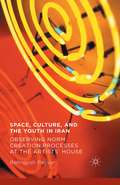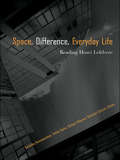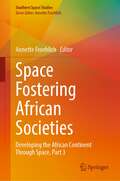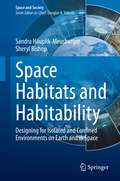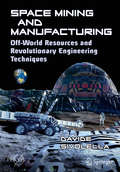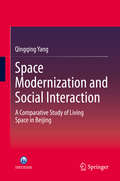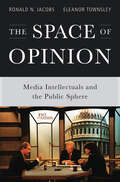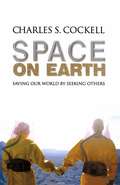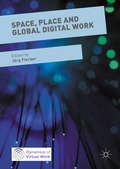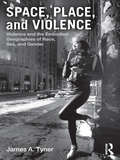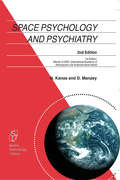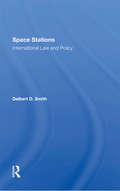- Table View
- List View
Space, Culture, and the Youth in Iran: Observing Norm Creation Processes at the Artists’ House
by Behnoosh PayvarThis book analyzes the Artists' House, a cultural center in Tehran, to place Iran's social and cultural transformation in a local-global context. The text addresses the interaction of Iranian youth with technology and mass communications, law, tradition, and contemporary questions concerning body, identity, and lifestyle.
Space, Difference, Everyday Life: Reading Henri Lefebvre
by Kanishka Goonewardena Stefan Kipfer Richard Milgrom Christian SchmidIn the past fifteen years, Henri Lefebvre’s reputation has catapulted into the stratosphere, and he is now considered an equal to some of the greats of European social theory (Bourdieu, Deleuze, Harvey). In particular, his work has revitalized urban studies, geography and planning via concepts like; the social production of space, the right to the city, everyday life, and global urbanization. Lefebvre’s massive body of work has generated two main schools of thought: one that is political economic, and another that is more culturally oriented and poststructuralist in tone. Space, Difference, and Everyday Life merges these two schools of thought into a unified Lefebvrian approach to contemporary urban issues and the nature of our spatialized social structures.
Space, Difference, Everyday Life: Reading Henri Lefebvre
by Kanishka Goonewardena Stefan Kipfer Richard Milgrom Christian SchmidIn the past fifteen years, Henri Lefebvre’s reputation has catapulted into the stratosphere, and he is now considered an equal to some of the greats of European social theory (Bourdieu, Deleuze, Harvey). In particular, his work has revitalized urban studies, geography and planning via concepts like; the social production of space, the right to the city, everyday life, and global urbanization. Lefebvre’s massive body of work has generated two main schools of thought: one that is political economic, and another that is more culturally oriented and poststructuralist in tone. Space, Difference, and Everyday Life merges these two schools of thought into a unified Lefebvrian approach to contemporary urban issues and the nature of our spatialized social structures.
Space Fostering African Societies: Developing the African Continent Through Space, Part 3 (Southern Space Studies)
by Annette FroehlichThis peer-reviewed book provides detailed insights into how space and its applications are, and can be used to support the development of the full range and diversity of African societies, as encapsulated in the African Union’s Agenda 2063. Following on from Part 1 and 2, which were highly acclaimed by the space community, it focuses on the role of space in supporting the UN Sustainable Development Goals in Africa, but covers an even more extensive array of relevant and timely topics addressing all facets of African development. It demonstrates that, while there have been significant achievements in recent years in terms of economic and social development, which have lifted many of Africa’s people out of poverty, there is still a great deal that needs to be done to fulfill the basic needs of Africa's citizens and afford them the dignity they deserve. To this end, space is already being employed in diverse fields of human endeavor to serve Africa’s goals for its future, but there is much room for further incorporation of space systems and data. Providing a comprehensive overview of the role space is playing in helping Africa achieve its developmental aspirations, the book will appeal to both students and professionals in fields such as space studies, international relations, governance, and social and rural development.
Space Habitats and Habitability: Designing for Isolated and Confined Environments on Earth and in Space (Space and Society)
by Sandra Häuplik-Meusburger Sheryl BishopThis book explores creative solutions to the unique challenges inherent in crafting livable spaces in extra-terrestrial environments. The goal is to foster a constructive dialogue between the researchers and planners of future (space) habitats. The authors explore the diverse concepts of the term Habitability from the perspectives of the inhabitants as well as the planners and social sciences.The book provides an overview of the evolution and advancements of designed living spaces for manned space craft, as well as analogue research and simulation facilities in extreme environments on Earth. It highlights how various current and future concepts of Habitability have been translated into design and which ones are still missing. The main emphasis of this book is to identify the important factors that will provide for well-being in our future space environments and promote creative solutions to achieving living spaces where humans can thrive. Selected aspects are discussed from a socio-spatial professional background and possible applications are illustrated.Human factors and habitability design are important topics for all working and living spaces. For space exploration, they are vital. While human factors and certain habitability issues have been integrated into the design process of manned spacecraft, there is a crucial need to move from mere survivability to factors that support thriving. As of today, the risk of an incompatible vehicle or habitat design has already been identified by NASA as recognized key risk to human health and performance in space. Habitability and human factors will become even more important determinants for the design of future long-term and commercial space facilities as larger and more diverse groups occupy off-earth habitats. The book will not only benefit individuals and organizations responsible for manned space missions and mission simulators, but also provides relevant information to designers of terrestrial austere environments (e.g., remote operational and research facilities, hospitals, prisons, manufacturing). In addition it presents general insights on the socio-spatial relationship which is of interest to researchers of social sciences, engineers and architects.
Space, Identity and Education: A Multi Scalar Framework
by Ceri Brown Michael DonnellyThis book details an innovative multi-scalar framework to examine the intersection of spatial levels in shaping social justice issues in education. Including an examination of key dimensions such as geographic divisions (between and within countries), school design, online learning, home-schooling, and student mobility, the framework is applied to analyse the interrelation between space, identity, and education. The authors reveal how this novel integration of scales is essential for a more comprehensive and probing understanding of educational inequalities. As an example of theoretical interdisciplinarity mobilised to tackle the urgent issues of our time, the twin dimensions of space and identity, discussed at multi-scalar levels, provides an invaluable theoretical resource for scholars and students of education, sociology and geography.
Space in the Medieval West: Places, Territories, and Imagined Geographies
by Fanny MadelineIn the last two decades, research on spatial paradigms and practices has gained momentum across disciplines and vastly different periods, including the field of medieval studies. Responding to this ’spatial turn’ in the humanities, the essays collected here generate new ideas about how medieval space was defined, constructed, and practiced in Europe, particularly in France. Essays are grouped thematically and in three parts, from specific sites, through the broader shaping of territory by means of socially constructed networks, to the larger geographical realm. The resulting collection builds on existing scholarship but brings new insight, situating medieval constructions of space in relation to contemporary conceptions of the subject.
Space in the Medieval West: Places, Territories, and Imagined Geographies
by Fanny MadelineIn the last two decades, research on spatial paradigms and practices has gained momentum across disciplines and vastly different periods, including the field of medieval studies. Responding to this ’spatial turn’ in the humanities, the essays collected here generate new ideas about how medieval space was defined, constructed, and practiced in Europe, particularly in France. Essays are grouped thematically and in three parts, from specific sites, through the broader shaping of territory by means of socially constructed networks, to the larger geographical realm. The resulting collection builds on existing scholarship but brings new insight, situating medieval constructions of space in relation to contemporary conceptions of the subject.
Space Invaders: Radical Geographies of Protest (Radical Geography)
by Paul RoutledgeSpace Invaders argues for the importance of a radical geographic perspective in enabling us to make sense of protests and social movements around the world. Under conditions of increasing global economic inequalities, we are witnessing the flourishing of grassroots people's movements fighting for improved rights. *BR**BR*Whether it be the alter-globalisation mobilisations of the turn of the century, the flurry of Occupy protests, or the current wave of anti-austerity mobilisations taking place, there is a geographical logic to all forms of protest whether that be through transforming landscapes, occupying enemy territory or developing solidarity and communication networks. *BR**BR*Paul Routledge takes a primarily auto-ethnographical perspective, drawing upon his extensive experience over the past thirty years working with various forms of protest in Europe, Asia and Latin America, to provide an account of how a radical geographical imagination can inform our understanding and the prosecution of protest.
Space Invaders: Radical Geographies of Protest (Radical Geography)
by Paul RoutledgeSpace Invaders argues for the importance of a radical geographic perspective in enabling us to make sense of protests and social movements around the world. Under conditions of increasing global economic inequalities, we are witnessing the flourishing of grassroots people's movements fighting for improved rights. *BR**BR*Whether it be the alter-globalisation mobilisations of the turn of the century, the flurry of Occupy protests, or the current wave of anti-austerity mobilisations taking place, there is a geographical logic to all forms of protest whether that be through transforming landscapes, occupying enemy territory or developing solidarity and communication networks. *BR**BR*Paul Routledge takes a primarily auto-ethnographical perspective, drawing upon his extensive experience over the past thirty years working with various forms of protest in Europe, Asia and Latin America, to provide an account of how a radical geographical imagination can inform our understanding and the prosecution of protest.
Space Mining and Manufacturing: Off-World Resources and Revolutionary Engineering Techniques (Springer Praxis Books)
by Davide SivolellaThis book produces convincing evidence that exploiting the potential of space could help solve many environmental and social issues affecting our planet, such as pollution, overcrowding, resource depletion and conflicts, economic inequality, social unrest, economic instability and unemployment. It also touches on the legal problems that will be encountered with the implementation of the new technologies and new laws that will need to be enacted and new organizations that will need to be formed to deal with these changes.This proposition for a space economy is not science fiction, but well within the remit of current or under development technologies. Numerous technologies are described and put together to form a coherent and feasible road map that, if implemented, could lead humankind towards a brighter future.
Space, Mobility, and Crisis in Mega-Event Organisation: Tokyo Olympics 2020's Atmospheric Irradiations (Routledge Advances in Sociology)
by Rodanthi TzanelliThis book advances an alternative critical posthumanist approach to mega-event organisation, taking into account both the new and the old crises which humanity and our planet face. Taking the delayed Tokyo 2020 Olympic Games as a case study, Tzanelli explores mega-event crisis and risk management in the era of extreme urbanisation, natural disasters, global pandemic, and technoscientific control. Using the atmospheric term ‘irradiation’ (a technology of glamour and transparency, as well as bodily penetration by harmful agents and strong affects), the book explores this epistemological statement diachronically (via Tokyo’s relationship with Western forms of domination) and synchronically (the city as a global cultural-political player but victim of climate catastrophes). It presents how the ‘Olympic enterprise’s’ ‘flattening’ of indigenous environmental place-making rhythms, and the scientisation of space and place in the Anthropocene lead to reductionisms harmful for a viable programme of planetary recovery. An experimental study of the mega-event is enacted, which considers the researcher’s analytical tools and the styles of human and non-human mobility during the mega-event as reflexive gateways to forms of posthuman flourishing. Crossing and bridging disciplinary boundaries, the book will appeal to any scholar interested in mobilities theory, event and environment studies, sociology of knowledge and cultural globalisation.
Space, Mobility, and Crisis in Mega-Event Organisation: Tokyo Olympics 2020's Atmospheric Irradiations (Routledge Advances in Sociology)
by Rodanthi TzanelliThis book advances an alternative critical posthumanist approach to mega-event organisation, taking into account both the new and the old crises which humanity and our planet face. Taking the delayed Tokyo 2020 Olympic Games as a case study, Tzanelli explores mega-event crisis and risk management in the era of extreme urbanisation, natural disasters, global pandemic, and technoscientific control. Using the atmospheric term ‘irradiation’ (a technology of glamour and transparency, as well as bodily penetration by harmful agents and strong affects), the book explores this epistemological statement diachronically (via Tokyo’s relationship with Western forms of domination) and synchronically (the city as a global cultural-political player but victim of climate catastrophes). It presents how the ‘Olympic enterprise’s’ ‘flattening’ of indigenous environmental place-making rhythms, and the scientisation of space and place in the Anthropocene lead to reductionisms harmful for a viable programme of planetary recovery. An experimental study of the mega-event is enacted, which considers the researcher’s analytical tools and the styles of human and non-human mobility during the mega-event as reflexive gateways to forms of posthuman flourishing. Crossing and bridging disciplinary boundaries, the book will appeal to any scholar interested in mobilities theory, event and environment studies, sociology of knowledge and cultural globalisation.
Space Modernization and Social Interaction: A Comparative Study of Living Space in Beijing (China Academic Library)
by Qingqing YangThis book concerns the Beijing Hutong and changing perceptions of space, of social relations and of self, as processes of urban redevelopment remove Hutong dwellers from their traditional homes to new high-rise apartments. It addresses questions of how space is humanly built and transformed, classified and differentiated, and most importantly how space is perceived and experienced. This study elaborates and expands Lefebvre’s “trialectic” of space on a theoretical level. The ethnography presented is a conversation with Tim Ingold’s argument about “empty space”. This research employs the ethnographic technique of participant-observation to secure a finely textured, detailed and micro-social account of local experience. Then, these micro-social insights are contextualized within macro-social structures of Chinese modernism by speaking to geographical concerns, orientalism and history.
The Space of Opinion: Media Intellectuals and the Public Sphere
by Ronald N. Jacobs Eleanor TownsleyWhile the newspaper op-ed page, the Sunday morning political talk shows on television, and the evening cable-news television lineup have an obvious and growing influence in American politics and political communication, social scientists and media scholars tend to be broadly critical of the rise of organized punditry during the 20th century without ever providing a close empirical analysis. What is the nature of the contemporary space of opinion? How has it developed historically? What kinds of people speak in this space? What styles of writing and speech do they use? What types of authority and expertise do they draw on? And what impact do their commentaries have on public debate? To describe and analyze this complex space of news media, Ronald Jacobs and Eleanor Townsley rely on enormous samples of opinion collected from newspapers and television shows during the first years of the last two Presidential administrations. They also employ biographical data on authors of opinion to connect specific argument styles to specific types of authors, and examine the distribution of authors and argument types across different formats. The result is a close mapping that reveals a massive expansion and differentiation of the opinion space. It tells a complex story of shifting intersections between journalism, politics, the academy, and the new sector of think tanks. It also reveals a proliferation of genres and forms of opinion; not only have the people who speak within the space of opinion become more diverse over time, but the formats of opinion-claims to authority, styles of speech, and modes of addressing publics-have also become more varied. Though Jacobs and Townsley find many changes, they also find continuities. Despite public anxieties, the project of objective journalism is alive and well, thriving in the older, more traditional formats, and if anything, the proliferation of newer formats has resulted in an intensified commitment (by some) to core journalistic values as clear points of difference that offer competing logics of distinction and professional justification. But the current moment does represent a real challenge as more and different shows compete to narrate politics in the most compelling, authoritative, and influential manner. By providing the first systematic study of media opinion and news commentary, The Space of Opinion will fill an important gap on research about media, politics, and the civil society and will attract readers in a number of disciplines, including sociology, communication, media studies, and political science.
The Space of Opinion: Media Intellectuals and the Public Sphere
by Ronald N. Jacobs Eleanor TownsleyWhile the newspaper op-ed page, the Sunday morning political talk shows on television, and the evening cable-news television lineup have an obvious and growing influence in American politics and political communication, social scientists and media scholars tend to be broadly critical of the rise of organized punditry during the 20th century without ever providing a close empirical analysis. What is the nature of the contemporary space of opinion? How has it developed historically? What kinds of people speak in this space? What styles of writing and speech do they use? What types of authority and expertise do they draw on? And what impact do their commentaries have on public debate? To describe and analyze this complex space of news media, Ronald Jacobs and Eleanor Townsley rely on enormous samples of opinion collected from newspapers and television shows during the first years of the last two Presidential administrations. They also employ biographical data on authors of opinion to connect specific argument styles to specific types of authors, and examine the distribution of authors and argument types across different formats. The result is a close mapping that reveals a massive expansion and differentiation of the opinion space. It tells a complex story of shifting intersections between journalism, politics, the academy, and the new sector of think tanks. It also reveals a proliferation of genres and forms of opinion; not only have the people who speak within the space of opinion become more diverse over time, but the formats of opinion-claims to authority, styles of speech, and modes of addressing publics-have also become more varied. Though Jacobs and Townsley find many changes, they also find continuities. Despite public anxieties, the project of objective journalism is alive and well, thriving in the older, more traditional formats, and if anything, the proliferation of newer formats has resulted in an intensified commitment (by some) to core journalistic values as clear points of difference that offer competing logics of distinction and professional justification. But the current moment does represent a real challenge as more and different shows compete to narrate politics in the most compelling, authoritative, and influential manner. By providing the first systematic study of media opinion and news commentary, The Space of Opinion will fill an important gap on research about media, politics, and the civil society and will attract readers in a number of disciplines, including sociology, communication, media studies, and political science.
The Space of the World: Can Human Solidarity Survive Social Media and What If It Can't?
by Nick CouldryOver the past thirty years, humanity has made a huge mistake. We handed over to big tech decisions that have allowed them to build what has become our "space of the world" – the highly artificial space of social media platforms where much of our social life now unfolds. This has proved reckless and has huge social consequences.The toxic effects on social life, young people’s mental health, and political solidarity are well known, but the key factor underlying all this has been missed: the fact that humanity allowed business to construct our space of the world at all and then exploit it for profit. In the process, we ignored two millennia of political thought about the conditions under which a healthy or even a non-violent politics is possible. We endangered the one resource that is in desperately short supply in the face of catastrophic climate change: solidarity. Is human solidarity possible in a world of continuous digital connection and commercially managed platforms, and what if it isn’t?In the first book of his trilogy, Humanising the Future, Nick Couldry offers a radical new vision of how to design our digital spaces so that they build, rather than erode, both solidarity and community. This trenchant and vividly written book stresses that we cannot afford not to care for our space of the world. We need to rebuild it together.
Space on Earth: Saving Our World By Seeking Others (Macmillan Science)
by C. CockellSir Arthur Clarke Award Winner Many environmentalists think going into space detracts from solving problems on Earth. Most space explorers feel environmentalism hampers their exploration of space. Leading astro-biologist Prof. Cockell argues that environmentalism and space exploration have one and the same objective, to ensure humanity has a home.
Space, Place and Global Digital Work (Dynamics of Virtual Work)
by Jörg FleckerThis edited volume seeks to enhance our understanding of the concepts of space and place in the study of digital work. It argues that while digital work is often presented as 'placeless', work always takes place somewhere with a certain degree of local embeddedness. Contributors to this collection address restructuring processes that bring about delocalised digital work and point out limitations to dislocation inherent in the work itself, and the social relations or the physical artefacts involved. Exploring the dynamics of global value chains and shifts in the international division of labour, this book explores the impact these have on employment and working conditions, workers' agency in shaping and coping with changes in work, and the new competencies needed in virtual organisational environments. Combining different disciplinary perspectives, the volume teases out the spatial aspects of digital work at different scales ranging from team level to that of global production networks.
Space, Place, and Violence: Violence and the Embodied Geographies of Race, Sex and Gender
by James A. TynerDirect, interpersonal violence is a pervasive, yet often mundane feature of our day-to-day lives; paradoxically, violence is both ordinary and extraordinary. Violence, in other words, is often hidden in plain sight. Space, Place, and Violence seeks to uncover that which is too apparent: to critically question both violent geographies and the geographies of violence. With a focus on direct violence, this book situates violent acts within the context of broader political and structural conditions. Violence, it is argued, is both a social and spatial practice. Adopting a geographic perspective, Space, Place, and Violence provides a critical reading of how violence takes place and also produces place. Specifically, four spatial vignettes – home, school, streets, and community – are introduced, designed so that students may think critically how ‘race’, sex, gender, and class inform violent geographies and geographies of violence.
Space, Place, and Violence: Violence and the Embodied Geographies of Race, Sex and Gender
by James A. TynerDirect, interpersonal violence is a pervasive, yet often mundane feature of our day-to-day lives; paradoxically, violence is both ordinary and extraordinary. Violence, in other words, is often hidden in plain sight. Space, Place, and Violence seeks to uncover that which is too apparent: to critically question both violent geographies and the geographies of violence. With a focus on direct violence, this book situates violent acts within the context of broader political and structural conditions. Violence, it is argued, is both a social and spatial practice. Adopting a geographic perspective, Space, Place, and Violence provides a critical reading of how violence takes place and also produces place. Specifically, four spatial vignettes – home, school, streets, and community – are introduced, designed so that students may think critically how ‘race’, sex, gender, and class inform violent geographies and geographies of violence.
Space Production by Migrants in China's Urban Villages: The Case of Beijing (Habitat-International: Schriften zur internationalen Urbanistik #27)
by Shiyu YangAs China races towards modernity, its cities are experiencing an unprecedented surge in urbanisation, characterised by a relentless influx of migrants and sprawling expansion into suburban realms. Shiyu Yang draws upon Henri Lefebvre's influential theoretical framework and applies it to case studies of two urban villages in Beijing to examine how migrants shape the social production of space in these districts. With a wealth of first-hand material from the field, this study provides essential insights into the ongoing processes and social dynamics that resonate with scholars from cross-disciplinary urban studies as well as practitioners in governance and urban planning.
Space Psychology and Psychiatry (Space Technology Library #22)
by Nick Kanas Dietrich ManzeyThe first edition of this book was voted Winner of the 2004 International Academy of Astronautics Life Sciences Award. The second edition deals with psychological, psychiatric, and psychosocial issues that affect people who live and work in space. Unlike other books that focus on anecdotal reports and ground-based simulation studies, this book emphasizes the findings from psychological research conducted during actual space missions. Both authors have been active in such research.
Space Stations: International Law And Policy
by Delbert D. SmithThis book explores the international law and policy relating to space stations in terms of specific barriers to utilization and considers methods or policies designed to overcome perceived barriers. It deals with the institutional possibilities and alternatives for space station ownership.
Space Stations: International Law And Policy
by Delbert D. SmithThis book explores the international law and policy relating to space stations in terms of specific barriers to utilization and considers methods or policies designed to overcome perceived barriers. It deals with the institutional possibilities and alternatives for space station ownership.
